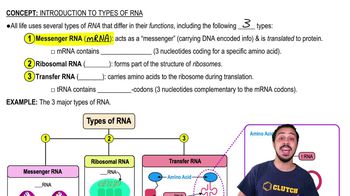Here are the essential concepts you must grasp in order to answer the question correctly.
Transcription
Transcription is the process by which RNA is synthesized from a DNA template. In this process, RNA polymerase binds to a specific region of the DNA and unwinds the double helix, allowing it to read the gene's coding sequence. The result of transcription is the formation of a complementary RNA strand, which can then be processed and translated into a protein.
Recommended video:
1) Initiation of Transcription
Types of RNA
There are several types of RNA produced in cells, each serving distinct functions. Messenger RNA (mRNA) carries the genetic information from DNA to the ribosome for protein synthesis, while transfer RNA (tRNA) and ribosomal RNA (rRNA) play roles in translating that information into proteins. Understanding these types is crucial for grasping how genes are expressed and proteins are made.
Recommended video:
Introduction to Types of RNA
Bacterial RNA Polymerase
Bacterial RNA polymerase is the enzyme responsible for synthesizing RNA from a DNA template in prokaryotic cells. Unlike eukaryotic cells, bacteria have a single type of RNA polymerase that transcribes all types of RNA, including mRNA, rRNA, and tRNA. This enzyme initiates transcription at specific promoter regions and is essential for gene expression in bacteria.
Recommended video:
DNA Polymerase Requirements
 Verified step by step guidance
Verified step by step guidance Verified video answer for a similar problem:
Verified video answer for a similar problem:



 5:51m
5:51m